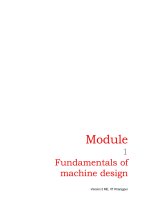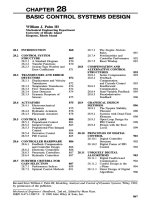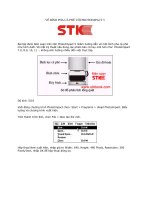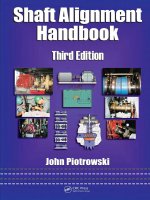Tài liệu Analog Integrated Circuit Design P1 docx
Bạn đang xem bản rút gọn của tài liệu. Xem và tải ngay bản đầy đủ của tài liệu tại đây (1.46 MB, 30 trang )
Con
tents
CHAPTER
1
INTEGRATED-CIRCUIT
DEVICES
AND
MODELLING
Semiconductors and
pn
Junctions 1
MOS
Transistors
16
Advanced
MOS
Modelling
39
Bipolar-Junction Transistors
42
Device
Model
Summary
56
SPICE-Modelling Parameters
6
1
Appendix
65
References
78
Problems
78
CHAPTER
2
PROCESSING
AND
LAYOUT
82
2.1
CMOS
Processing
82
2.2
Bipolar
Processing
95
2.3
CMOS Layout
and
Design Rules
96
4
2.4
Analog Layout Considerations 105
2.5
Latch-Up
1
18
2.6
References
12
1
2.7
Problems
121
CHAPTER
3
BASIC
CURRENT
MIRRORS
AND
SINGLE-STAGE
AMPLIFIERS
125
Simple
CMOS
Current
Mirror
125
Common-Source Amplifier
128
Source-Follower
or
Common-Drain Amplifier
129
Common-Gate Amplifier
132
Source-Degenerated Current Mirrors 13
5
High-Output-Impedance Current
Mirrors
137
Cascode Gain
Stage
140
MOS
Differential
Pair and Gain Stage
142
Bipolar Current Mirrors
146
Bipolar
Gain
Stages
1
49
Contents
xi
3.1
1
Frequency Response
154
3.12
SPICE
Simulation Examples
169
3.13
References 176
3.14
Problems
176
-\
CHAPTER
4
NOISE
ANALYSIS
AND
MODELING
4.1
Time-Domain Analysis
18
1
4.2
Frequency-Domain Analysis
1
86
4.3
Noise
Models
for
Circuit Elements
196
4.4
Noise Analysis Examples
204
4.5
References
216
4.6
Problems
2
17
CHAPTER
5
BASIC OPAMP DESIGN AND COMPENSATION
5.1
Two-Stage CMOS Opamp
22
1
5.2
Feedback and Opamp Compensation
232
5.3
SPICE
Simulation Examples
25
1
5.4
References
252
5.5
Problems
253
4
CHAPTER
6
ADVANCED
CURRENT
MIRRORS AND
~PAMPS
Advanced Current Mirrors 256
Folded-Cascode Opamp
266
Current-Mirror Opamp 273
Linear Settling
Time
Revisited 278
Fully Differential Opamps
280
Common-Mode Feedback
Circuits
287
Current-Feedback Opamps
29
1
SPICE Simulation Examples
295
References
299
Problems
300
v
CHAPTER
7
COMPARATORS
7.1
Using
an
Opamp for
a
Comparator
304
7.2
Charge-Injection Errors
308
7.3
LatchedComparators
317
7.4
Examples
of
CMOS and BiCMOS Comparators
32
1
7.5
Examples of Bipolar Comparators
328
7.6
References
330
7.7
Problems
33
1
xii
Contents
CHAPTER
8
SAMPLE AND HODS, VOLTAGE REFERENCES,
AND
TRANSLINEAR CIRCUITS
Performance
of
Sample-and-Hold Circuits
334
MOS Sample-and-Hold Basics
336
Examples of CMOS
S/H
Circuits
343
Bipolar and BiCMOS Sample and Holds
349
Bandgap Voltage Reference Basics
353
Circuits for Bandgap References
357
Translinear Gain Cell
364
Translinear Multiplier
366
References
368
Problems
370
CHAPTER
9
DISCRETE-TIME SIGNALS
Overview
of
Some Signal Spectra
373
Laplace Transforms of Discrete-Time
Signals
374
Z-Transform
377
Downsampling
and
Upsampling
379
Discrete-Time Filters
382
Sample-and-Hold Response
389
References
39
1
Problems
391
CHAPTER
10
SWITCHED-CAPACITOR
CIRCUITS
Basic
Building Blocks
394
Basic Operation and Analysis
398
First-Order Filters
409
Biquad
Filters
41
5
Charge Injection
423
Switched-Capacitor
Gain
Circuits
427
Correlated Double-Sampling Techniques
433
Other Switched-Capacitor Circuits
434
References
44
1
Problems
443
CHAPTER
1
1
DATA CONVERTER FUNDAMENTALS
1
1.1
Ideal
DIA
Converter
445
1
1.2
Ideal
AID
Converter
447
1
1.3
Quantization Noise
448
1
1.4
Signed Codes 452
Con
tents
xi11
1 1.5
Performance Limitations
454
11.6
References
461
11.7
Problems
461
CHAPTER
12
NYQUIST-RATE D/ACONVERTERS
12.1
Decoder-Based Converters
463
12.2
Binary -Scaled Converters
469
12.3
Thermometer-Code
Converters
475
12.4
Hybrid Converters
48
1
12.5
References
484
12.6
Problems
484
CHAPTER
1
3
NYQUIST-RATE
AID
CONVERTERS
Integrating Converters
487
Successive-Approximation Converters
492
Algorithmic
(or
Cyclic)
AID
Converter
504
Hash (or
Parallel)
Converters
507
Two-Step
PJD
Converters
5
13
Interpolating
A/D
Converters
5
16
Folding
AID
Converters
5
19
Pipelined
AD
Converters
523
Time-Interleaved
AD
Converters
526
References
527
Problems
528
CHAPTER
1
4
OVERSAMPUNG
CONVERTERS
Oversampling without Noise Shaping
5
3
1
Oversampling with Noise
Shaping
538
System Architectures
547
Digital Decimation Filters
55 1
Higher-Order Modulators
555
Bandpass Oversampling Converters
557
Practical Considerations
559
Multi-Bit Oversampling Converters
565
Third-Order
A/D
Design Example
568
References
57
1
Problems
572
CHAPTER
15
CONTINUOUS-TIME FILTERS
15.1
Introduction to
G,-C
Filters
575
15.2
Bipolar Transconductors
584
xiv
Contents
CMOS
Transconductors Using Triode Transistors
597
CMOS
Transconductors
Using
Active
Transistors
607
BiCMOS
Transconductors
6
16
MOSFET-C
Filters 620
Tuning Circuitry 626
Dynamic
Range
Performance 635
References
643
Problems
645
CHAPTER
16
PHASE-LOCKED
LOOPS
16.1
Basic Loop Architecture
648
16.2
PLLs
with
Charge-Pump
Phase
Comparators
663
16.3
Voltage-Controlled Oscillators
670
16.4
Computer Simulation of
PLLs
680
16.5
Appendix
689
16.6
References 692
16.7
Problems
693
INDEX
CHAPTER
Integrated-Circuit
Devices
and
Modelling
In this chapter, the operation and modelling of semiconductor devices are described.
Although it is possible to do simple integrated-circuit design with a basic knowledge
of
semiconductor device modelling, for high-speed state-of-the-art design, an in-
depth understanding of the second-order effects of device operation and their model-
ling is considered critical.
It is assumed that most readers have been introduced to transistors and their
basic
modelling in a previous course. Thus, fundamental semiconductor concepts are only
briefly reviewed. Section
1.1
describes
pn
junctions (or diodes). This section is
important
in
understanding the parasitic capacitances in many device models, such as
junction capacitances. Section
1.2
covers
MOS
transistors and modelling. It should be
noted that this section relies to some degree on the material previously presented in
Section 1.1, in which depletion capacitance is covered. Section 1.4 covers
bipolar-
junction transistors and modelling.
A
summary of device models and important equa-
tions
is
presented in Section
1.5.
This
summary
3
particularly useful for a reader who
already has a good background in transistor modelling,
in
which case the summary
can be used to follow the notation used throughout
the
remainder of this book.
Ln
addition, a
brief
description is given of the most important process-related parameters
used in
SPICE
modelling. Finally, this chapter concludes with
an
Appendix contain-
ing derivations of the more physically based device equations.
SEMICONDUCTORS
AND
pn
JUNCTIONS
A
semiconductor is
a
crystal lattice structure that
can
have free electrons (which
are
negative carriers) andor free holes (which are an absence of electrons and are equiva-
lent
to
positive carriers).
The
type of semiconductor typically used is silicon (com-
monly called
sand).
This material has
a
valence of four, implying that each atom has
four free electrons to share with neighboring atoms when forming the covalent bonds of
the crystal lattice.
Intrinsic
silicon
(i.e.,
undoped silicon) is a very pure crystal structure
having equal numbers of free electrons and holes. These free carriers are those electrons
or holes that have gained enough energy due to thermal agitation to escape their bonds.
At
room temperature, there are approximately
1
-5
x
10'' carriers of each type per cm3,
or
equivalently
1.5
x
10
l6
camers/m3. The number of carriers approximate1
y
doubles
for every
11
"C
increase in temperature.
2
Chapter
1
Integrated-Circuit
Devices
and
Modelling
If
one dopes silicon with a pentavalent impurity (i.e., atoms of an element having
a valence of five, or equivalently five electrons in the outer shell, available when
bonding with neighboring atoms), there will be almost one extra free electron for
every impurity atom.
'
These free electrons
can
be used to conduct current.
A
pentava-
lent impurity is said to
donate
free electrons to the silicon crystal, and thus the impu-
rity is known as a
donor.
Examples of donor elements are phosphorus,
P,
and arsenic,
AS.
These impurities are also called n-type dopants since the free carriers resulting
from their use have negative
charge.
When an n-type impurity
is
used, the total num-
ber of negative carriers or electrons is almost the same as
the
doping concentration,
and is much greater than the number of free electrons
in
intrinsic silicon. In other
words,
where
fl,
denotes the free-electron concentration in n-type material and
N,
is
the
doping concentration (with the subscript
D
denoting donor). On
the
other hand,
the
number
of
free holes in n-doped material
will
be much less than the number of holes
in
intrinsic silicon and can
be
shown
[Sze,
198
I] to be given by
Here,
ni
is
the
carrier
concentration
in
intrinsic silicon.
Similarly, if one dopes silicon with atoms having a valence of three, for example,
boron
(B),
the concentration of positive carriers o_r holes
will
be approximately equal
to the
acceptor
concentration,
NA
,
and the number
of
negative carriers in the p-type silicon,
n,
,
is given by
EXAMPLE
1.1
Intrinsic silicon is doped with boron at a concentration of atoms/m! At
room temperature, what
are
the concentrations of holes and electrons in the
3
resulting doped silicon? Assume that
ni
=
1.5
x
10
l6
carriers/
rn
.
Solution
The hole concentration,
pp
,
will approximately equal the doping concentration
(pp
=
N,
=
lo2'
holes/m3
).
The
electron concentration
is
found from
(1.4)
to
be
1.
In
fact,
there
will
be
slightly fewer mobile
carriers
than
the
number
of
impurity
atoms
since
some
of
the
free
electrons
from the
dopants
have
recombined
with holes.
However.
since
the
number
of
holes
of
intrin-
sic silicon
is
much
less
than
typical
doping concentrations,
this
inaccuracy
is
small.
1.1
Semiconductors and
pn
Junclions
3
Such
doped silicon is referred to as
p
type
sincc
it
has many more free holes
than
frce
electrons.
Diodes
To realize a diode, or, equivalently, a
pn
junction, one part of a semiconductor is
doped
n
type. and a closely adjacent part
is
doped
p
-
tyye, as shown in
Fig.
1.1.
Mcl-c
the diode. or junction, is formed between the
p'
regon and the
n
region. It should be
noted that the superscripts indicate the relative doping levels. For examplc, the
p-
bulk
region might have
an
impurity concenrration of
5
x
10"
carriers/m3, whereas
the
p+
and
n+
regions would be doped more heavily to a value around
10'"o
10'~
carri-
ers/ni3. Also. note that the metal contacts to the diode (in this case,
aluminum)
are
connected
to
a heavily dopcd region as opposed to
a
lightly doped region: othenvise
a
Schntrk,~
dinda
woultl occur. (Schottky diodes are discussed on page
15.)
Thus, in
order
not
to
makc
a Schottky diode. the connection to
the
n
region is actually made
via
the
nt
region.
v
In
the
p*
side,
a
larpe number of free positive carriers are available, whereas
in
the
n
side. many f?ee negative carriers are avaifable. The holes in the
pC
side will tend
to disperse or diffuse
into
the
n
side. whereas the-free electrons in
the
n
side will tend
-
lo diffuse to the
p'
side. This process
is
very similar
to
two
gases randonily cliffi~sing
together.
This
diffusion lowers the concentration of free carriers in the region between
rhe two sides. As the two types of camers diffuse together. they recombine. Every
electron that diffuses from the
n
side
to
the
p
side leaves behind a
bound
positive
charge close to
the
bxnsition region.
Similarly,
every
hole
that diffuses from the
p
side
leaves behind a bound electron near the transition region. The end
result
is shown
in
Fig.
1.2. This diffusion of free carriers creates
a
depletior~
regiorz
at the jul~ction
of
the
two sides where no free carriers exist, and which has
a
net negative charge on
the
p'
side
and
a
net positive charge on the
n
side.
The
rocal amount
of
exposed
or
bound
Anode
SiO,
Cathode
9
Al
Anode
=
$;
-
I1
_______
___
Cathode
I
Anode
I1
u
_-___
___
Cathode
pn
junction
P-
Bulk
Fig.
1.1
A
cross
section
of
a
pn
diode.
4
Chapter
1
Integrated-Circuit Devices
and
Modelling
Electric
field
charge on the two sides
of
the junction must be equal for charge neutrality. This
requirement causes the depletion region to extend farther into the more lightly doped
n
side than into the
p+
side.
As
these bound charges are exposed, an electric field develops going from the
n
side to the
p
side. This
electric field
is
often called the built-in potential of
the
junc-
tion.
It
opposes the diffusion of free carriers until there
is
no
net movement of charge
under open-circuit and steady-state conditions. The built-in voltage of
an
open-circuit
pn
junction
is
given
by
Sze [I9811
as
P+
where
kT
vT
=
-
(I.7)
9
with
T
being the temperature
in
degrees Kelvin
(
=
300
OK
at
room
temperature),
k
being
Boltzrnann'
s
constant
(
1.38
x
1
o-~~
JK-I
),
and
q
being the
charge
of
an
elec-
tron
(
1.602
x
1
0-19
C
).
At room temperature,
V,
is
approximately
26
mV.
-
EXAMPLE
1.2
a
A
pn
junction
has
N
A
=
1
02'
holes/m3 and
N
=
electrons/m3
.
What is
3
the
built-in
junction potential? Assume that
ni
=
1.5
x
1016
canierslrn
.
++\
+++
+ + +
+++
+++
Solution
Using
(1.6),
we
obtain
Fig.
1.2
A
simplified
model
of
a
diode.
Immob$
Im\obile
Note
that
a
depletion
region
exists
at
the
negative
Depletion
positive
junction
due
to
diffusion
and
extends
far-
charge region charge
ther
into
the more
lightly doped
side.
n
1
.1
Semiconductors
and
pn
Junctions
5
This is a typical value for the built-in potential of a junction with one side
heavily doped. As an approximation,
we
will normally use
@,
E
0.9
V
for the
built-in potential of a junction having one side heavily doped.
Reverse-Biased
Diodes
A silicon diode having an anode-to-cathode (i.e.,
p
side to
n
side) voltage of
0.4
V
or less will not be conducting appreciable current.
In
this case,
it
is said to be
reverse biused.
If
a diode is reverse biased, current
flow
is
primarily
due to ther-
mally generated carriers
in
the depletion
region,
and
it
is
extremely
small.
Although
this reverse-biased current is only weakly dependent on the applied voltage,
the
reverse- biased current
is
directly proportional to
the
area
of
the
diode
junction.
However, an effect
that
should not be ignored, particularly at high frequencies, is
the junction capacitance of a diode.
In
reverse-biased diodes, this junction capaci-
tance is due to varying charge storage in the depletion regions and is modelled
as
a
depletion capacitance.
To
determine the depletion capacitance,
we
first state the relationship between the
depletion widths and the applied reverse voltage,
VR
[Sze,
198
11.
Here,
E,
is the permittivity of free space (equal to 8.854
x
lo-"
Flrn),
V,
is
the
reverse-bias voltage of the diode, and
K,
is
the relative permittivity of silicon (equal
to
11.8).
It should be noted that these equations assume that the doping changes
abruptly from
the
n
to
the
p
side.
From the above equations, we see that if one side of the junction is more heavily
doped than the other, the depletion region
will
extend mostly on the lightly doped
side. For example,
if
NA
>>
ND
(i.e., if the
p
region is more heavily doped), we
can
approximate
(
1.9) and (1.10)
as
Indeed, for this case
This special case is called a
single-sided diode.
6
Chapter
1
IntegratedCircuit
Devices
and
Modelling
EXAMPLE
1.3
For
a
pn
junction having
N
A
=
1
02'
holes/rn3 and
No
=
electrons/m3
,
what are the depletion-layer depths
for
a
5-V
reverse-bias voltage?
Solution
Since
N
A
>>
N
and we already have found in Example 1.2 that
0,
=
0.9
V,
we can use (1.1
I)
to find
Note that the depletion width in the lightly doped
n
region is
1,000
times greater
than
that in the more heavily doped
p
region.
The
charge stored in the depletion region, per unit cross-sectional area, is found
by multiplying the depletion-region width by the concentration of
the
immobile
charge
(which is approximately equal to
q
times the impurity doping density).
For
example, on the
n
side, we find the charge in the depletion region to be given
by
mul-
tiplying
(
l
-9)
by
q
N
,,
resulting
in
This amount
of
charge must also equal
Q-
on
the
p
side since there is charge equality.
In
the
case
of
a
single-sided diode when
NA
>>
ND,
we have
Note that this result is independent of the impurity concentration on
the
heavily doped
side. Thus, we see from
the
above relation that
the
charge stored in the depletion
region
is dependent on
the
applied reverse-bias voltage.
It
is
this
charge-voltage rela-
tionship
that
is modelled
by
a nonlinear depletion capacitance.
For small changes in the reverse-biased junction voltage, about
a
bias voltage,
we
can find an equivalent
small-signal
capacitance, C,,
by
differentiating (1.15) with
respect to
VR.
Such a differentiation results in
1
.1
Semiconductors
and
pn
Junctions
7
where
Cp
is the depletion capacitance per unit area at
V,
=
0
and is given
by
In
the
case of a one-sided diode with
NA
>>
ND,
we
have
where
now
It should
be
noted that many of the junctions encountered in integrated circuits
are one-sided junctions with
the
lightly doped side being the substrate or sometimes
what is called the
well.
The more heavily doped side is often used to form
a
contact to
interconnecting metal. From
(1.20),
we
see that, for these one-sided junctions, the
depletion capacitance is approximately independent of the doping concentration on
the
heavily doped side, and
is
proportional
to
the square root of the doping concentra-
tion of the more lightly doped side. Thus, smaller depletion capacitances are obtained
for more lightly doped substrates-a strong incentive
.c
to strive
for
lightly doped sub-
strates
.
Finally, note that
by
combining
(1.15)
and
(l.l8),
we can express the equation for
the immobile charge on either side of a reverse-biased junction
as
As
seen in Example
1.6,
this equation is useful when one is approximating the large-
signal charging (or discharging) time for a reverse-biased diode.
EXAMPLE
1.4
Far
a
pn
junction having
NA
=
lo2'
holeslm3 and
ND
=
electrons/rn3
,
what is the total zero-bias depletion capacitance for
a
diode of
area
10
pm
x
10
pm
?
What
is
its depletion capacitance for
a
3-V
reverse-bias voltage?
Solution
Making
use of
(
1.20),
we
have
8
Chapter
1
IntegratedCircuit
Devices
and
Modelling
Since
the
diode
area
is
100
x
lo-'*
m2,
the total zero-bias depletion capacitance
is
CTjo
=
100
x
10-l~
x
304.7
x
lo-'
=
30.5
fF
(
1.23)
At
a
3-V
reverse-bias voltage,
we
have from
(1.19)
As
expected,
we
see
a
decrease
in junction capacitance
as
the width of the
deple-
tion
region
is
increased.
Graded
Junctions
All of the above equations assumed an abrupt junction where the doping concentra-
tion changes quickly from
p
to
t~
over
a
small
distance.
Although this
is
a good
approximation for many integrated circuits, it
is not always true. For example, the
collector-to-base junction
of
a bipolar transistor
is
most commonly
realized
as a
graded
junction.
In
the
case
of
graded
junctions, the exponent
112
in
Eq.
(1.15)
is
inaccurate, and
a
better value to use is an
exponent
closer to unity, perhaps
0.6
to
0.7.
Thus,
for
graded junctions,
(1.15)
is typically written
as
-
where
m
is
a constant typically around 1/3.
Differentiating
(
1.25)
to find the depletion capacitance,
we
have
This
depletion capacitance can
also
be
written as
where
From
(1.27),
we see
that
a graded junction
results
in
a depletion capacitance
that
is
less
dependent
on
VR
than the equivalent capacitance in
an
abrupt junction.
In
other
words, since
m
is
less than
0.5,
the depletion capacitance
for
a graded junction is
1 .1
Semiconductors and
pn
Junctions
9
more linear than that for an abrupt junction. Correspondingly, increasing the reverse-
bias voltage for a graded junction is not as effective
in
reducing the depletion capaci-
tance as it is for an abrupt junction.
Finally, as in
the
case of an abrupt junction, the depletion charge on either side of
the junction can also be written as
EXAMPLE
1.5
Repeat Example
1.4
for a graded junction with
m
=
0.4.
Solution
Noting once
again
that
NA
>>
N,,
we
approximate
(1.28)
as
resulting in
which, when multiplied by the diode's area
nf
10
Lm
x
10
Lm, results
in
CTjo
=
8.1
fF
(1
-32)
For
a
3-V
reverse-bias voltage, we have
lurge-Signal
Junction
Capacitance
The
equations for
the
junction capacitance given above are only valid for small
changes in the reverse-bias voltage. This limitation is due to the fact that
Cj
depends on
the size of
the
reverse-bias voltage instead of being a constant. As a result, it is
extremely
diff~cult and time consuming
to
accurately take this nonlinear capacitance
into account when calculating the time to charge or discharge
a
junction over a
large
voltage change.
A
commonly used approximation
when
analyzing the transient
response for large voltage changes is to use
an
average
size
for the junction capacitance
by calculating the junction capacitance at the two extremes of the reverse-bias voltage.
Unfortunately,
a
problem with
this
approach
is
that when the diode is forward biased
with
VR
E
-aO.
Eq.
(I. 17) "blows up" (i.e., is equal to infinity). To circumvent this
10
Chapter
1
IntegratedCircuit
Devices
and
Modelling
problem, one
can
instead calculate the charge stored
in
the junction for the two extreme
values of applied voltage (through the use of
(1.21)), and then through the use of
Q
=
CV
,
calculate the average capacitance according to
where
V,
and
V,
are the two voltage extremes [Hodges,
19881.
From (1.2
I),
for
an
abrupt junction with reverse-bias voltage
Vi,
we have
C)(Vi)
=
2CjoOo/' (1.35)
Therefore,
One
special case often encountered
is
charging
a
junction from
0
V to
5
V.
For this
special case, and using
0,
=
0.9
V, we
find
that
Ci-av
=
0.56Ci,,
(1
-37)
Thus, as
a
rough approximation to quickly estimate the charging time of
a
junction
capacitance from
0
V
to
5
V
(or
vice versa), one can use
It will be seen in the following
example that (1.37) compares well with a
SPICE
sim-
ulation.
EXAMPLE
1.6
For the circuit
shown
in
Fig.
1.3, where a reverse-biased diode is being charged
from
0
V
to
5
V, through
a
10-
kR
resistor, calculate the time required to charge
the diode from
0
V
to
3.5
V. Assume that
C,,
=
0.2
f~/(~rn)~ and that the
diode has an area of
20
pm
x
5
pm
.
Compare your answer to
that
obtained
using
SPICE.
Repeat the question for the case of the diode being discharged
from
5
V
to
1.5
V.
Solution
The
total small-signal capacitance of the junction
at
0-V
bias voltage is obtained
by multiplying
0.2
f~l(~m)~ by the junction area to obtain
Using
(1.37),
we have
1.1
Semiconductors
and
pn
Junctions
1 1
fig.
1.3
(a)
The
circuit
used
in
Example
1.6;
(b)
its
RC
approximate
equivalent.
resulting in
a
time
constant
of
It
is
not
difficult
to
show
that
the
time it tbs
for
a first-order circuit
to
rise
(or
fall)
70
percent
of
its final value
is
equal
to
1.27
.
Thus,
in
this
case,
t,,,
=
1.22
=
0.13
ns
(
1.42)
As
a
check,
the
circuit of
Fig.
1.3(a)
was
analyzed using
SPICE.
The
input
data
file
was as
follows:
R
12 10k
D
0
2
DMOD
*
VIN
10
dc
2.5
PULSE
(0
5
0
10p
lop
0.49n
1.0n)
*
.MODEL
DMOD D(CJO=O.O2E-
1
2)
*
.OPTIONS
NUMDGT=5
ITLI
=500
.WIDTH OUT=80
.TRAN
0.0
1n
1
.On
TRAN
V(2)
.END
The
SPICE
simulation
gave
a
0-V
to
3.5-V
rise
time
of
0.14
ns
and
a
5-V
to
1.5-V
fall
time
of
0.12 ns.
These
times
compare favorably
with the
0.13
ns
pre-
dicted.
The reason for
the different values
of
the
rise
and
fall
times
is
the
nonlin-
earity
of
the
junction capacitance.
For
smaller
bias
voltages it
is
larger
than that
12
Chapter
1
IntegratedCircuit Devices
and
Modelling
predicted by (1.37), whereas for larger bias voltages it is smaller.
If
we use the
more accurate approximation of (1.36) for the rise time with
V2
=
3.5
and
V,
=
0
V,
we find
Also, for the fall time, we find that
These more accurate approximations result in
1+709
=
0.144
ns
and
t-,,,
=
0.1
14
ns
in
closer agreement with
SPICE.
Normally, the extra accuracy that results from
using
(1.36)
instead of
(1.37)
is not worth the extra complication because one
seldom knows the area of
Cjo
to better than
20
percent accuracy.
Fotward-Biased
Junctions
-L
A
positive voltage applied from the
p
side to the
n
side
of a diode reduces the electric
field opposing the diffusion of the free carriers across the depletion region. It also
reduces the width of the depletion region. If this forward-bias voltage is large enough,
the carriers will start to diffuse across the junction, resulting in a current flow from the
anode to the cathode. For silicon, appreciable diode current starts to occur for a
forward-
bias voltage around 0.5
V.
For germanium and gallium arsenide semiconductor mate-
rials, current conduction starts to occur around 0.3
V
and
0.9
V,
respectively.
When the junction potential is sufficiently lowered
for
conduction to occur, the
carriers
diffuse
across the junction due to the large gradient in
the
mobile carrier con-
centrations. Note that
there
are more carriers diffusing from the heavily doped side to
the lightly doped side than from the lightly doped side to the heavily doped side.
After the carriers cross the depletion region, they greatly increase the
minority
charge
at the edge of the depletion region. These minority carriers will diffuse away
from the junction toward the
bulk.
As they diffuse, they recombine with the majority
carriers, thereby decreasing their concentration. This concentration gradient of the
minority charge (which decreases the farther one gets from
the
junction) is responsi-
ble for the current flow near the junction.
The majority carriers that recombine with the diffusing minority carriers come
from
the
metal contacts at
the
junctions because
of
the forward-bias voltage. These
majority carriers flow across the
bulk,
from the contacts to
the
junction, due
to
an
electric
field
applied across the bulk. This current flow is called
drip.
It results in
1 .1
Semiconductors
and
pn
Junctions
13
small potential drops across the bulk, especially in the lightly doped side. Typical val-
ues of this voltage drop might be
50
mV
to
0.1
V,
depending primarily on the doping
concentration of the lightly doped side, the distance from the contacts to the junction,
and the cross-sectional
area of the junction.
In the forward-bias region, the current-voltage relationship is exponential and can
be shown (see Appendix) to be
I,
=
I,e
V,/V,
(1
-47)
where
VD
is the voltage applied across the diode and
I,
is known as the
scale current
and is seen to be proportional to the area of the diode
junction,
AD,
and inversely proportional to the doping concentrations.
Junction
Capacitance of
Foward-Biased
Diode
When a junction changes from reverse biased (with little current through it) to for-
ward biased (with significant current flow across it), the charge being stored near and
across the junction changes.
Part
of
the
change in charge is due to the change in the
width of the depletion region and therefore the amount of immobile charge stored in
it.
This
change in charge is modelled by the depletion
-
capacitance,
Ci,
similar to when
the junction is reverse biased.
An
additional change in charge storage is necessary
to
account for the change of the minority carrier concentration close to the junction
required for the diffusion current to exist. For example, if
a forward-biased diode cur-
rent is to double, then the slopes of the minority charge storage at the diode junction
edges must double, and this,
in
turn, implies that the minority charge storage must
double. This component is modelled by another capacitance,
cajled the
difusion
capacitance,
and denoted C,.
The
diffusion capacitance
can
be
shown (see
Appendix)
to
be
where
TT
is
the transit time of the diode. Normally
tT
is
specified for a given technol-
ogy, so that one can calculate the diffusion capacitance.
Nofe
that
the
di@sion
capac-
itance of
a
forward-biased junction is proportional to
the
diode current.
The total capacitance of the forward-biased junction is the sum of the diffusion
capacitance,
Cd.
and the depletion capacitance,
C,.
Thus, the total junction capaci-
tance is given by
For a forward-biased junction, the depletion capacitance,
Cj,
can be roughly approxi-
mated by
2Cjo
The accuracy of
this
approximation is not critical since the diffusion
capacitance is typically much larger than the depletion capacitance.
14
Chapter
1
IntegratedCircuit
Devices
and
Modelling
Finally, it should
be
mentioned that as
a
diode is turned off for
a
short
period
of
time
a
current will
flow
in the negative direction until the minority charge is removed.
This behavior does not occur in Schottky diodes since they
do
not have minority
charge storage.
Small-Signal Model of
a
Forward-Biased
Diode
A
small-signal equivalent model for a forward-biased diode is shown
in
Fig.
1.4.
A
resistor,
r,,
models
the
change in the diode voltage,
VD,
that occurs when
ID
changes.
Using
(1.47),
we
have
This resistance is called the incremental resistance of the diode. For very accurate
modelling,
it
is sometimes necessary
to
add the series resistance due to the bulk and
also the resistance associated
with
the contacts. Typical values for the contact resis-
tance (caused
by
the work-function2 difference between metal and silicon) might
be
20
Qto40
a.
By combining
(1.49)
and
(1.5
l),
we see that
an
alternative equation for the diffu-
sion
capacitance,
C,,
is
Since for moderate forward-bias currents,
Cd
>>
Ci
,
the total small-signal capaci-
tance
is
CT
=
C,,
and
r,CT
T~
(1.53)
Thus,
for charging or discharging a forward-biased junction with
a
current source
having an impedance much larger than
rd,
the time constant of the charging is approx-
imately
equal
to
the
transit
time
of
the
diode
and
is
independent
of
the diode
current.
For
smaller diode currents, whe~
Cj
becomes important, the charging or discharging
time constant of the circuit becomes larger than
zT
.
I
Fig.
1.4
The
small-signal
model
for
a
forward-biased junction.
2.
The
work-function of
a
material
is
defined
as
the
minimum
energy
required
to remove
an
electron
at
the
Femi
level
to
the
outside vacuum
regton.
1.1
Semiconductors
and
pn
Junctions
15
EXAMPLE
1.7
A
given diode has a transit
time
of
100
ps and is biased at
1
rnA
.
What are the
values of
its
small-signal resistance
and
diffusion capacitance? Assume room
temperature, so that
V,
=
kT/q
=
26
mV.
Solution
We
have
and
Note that
this
di.ffusion capacitance is over
100
times
larger
than
the
total deple-
tion capacitance found
in
Examples
1.4
md
1.5.
Schoiky
Diodes
A
different type
of
diode, one often used
in
microcircuit
design,
is
realized by contact-
ing
metal to
a
lightly doped sem.iconductor
region
(rather
than
a
heavily
doped
region)
as shown
in
Fig.
1.5.
Notice hat
the
aluminum anode is
in
direct contact
with
a
rela-
tively lightly doped
n-
region. Because
the
n-
region is
relatively
lightly doped,
the
work-function difference between
the
alu~ninum contact
and
the
n-
silicon is larger
than would be the
case
for aluminum contacting
to
an
n+
region, as occurs at the cath-
ode. This causes
a
depletion region
and,
correspondingly,
a
diode to occur at
the
inter-
face behveen
the
aluminum anode and the
n-
silicon region.
This
diode has Qfferent
characreristics
than
a normal
pn
junction diode. First,
its
voltage drop when forward
Anode
Al
Cathode
Schottky
diode
depletion region
P-
Bulk
Anode
Cathode
Fig.
1.5
A
cross
section
of
o
Schottky
diode
16
Chapter
1
lntegratedCircuitDevicesandModelling
biased is smaller. This voltage drop is dependent on the metal used; for aluminum it
might be around
0.5
V.
More importantly, when the diode is forward biased, there is
no
minority-charge storage
in
the lightly doped
n-
region. Thus, the small-signal
model of a forward-biased Schottky diode has
Cd
=
0
(with reference to Fig.
1.4).
The
absence of this diffusion capacitance makes the diode much faster. It is particu-
larly faster when turning off, because it is not necessary to remove the minority charge
first. Rather, it is only necessary to discharge the depletion capacitance through about
0.2
v.
Schottky diodes have been used extensively in bipolar logic circuits. They are
also used in a number of high-speed analog circuits, particularly those realized in gal-
lium arsenide
(GaAs)
technologies, rather than silicon technologies.
1.2
MOS
TRANSISTORS
Presently, the most popular technology for realizing microcircuits makes use of
MOS
transistors. Unlike most bipolar junction transistor
(BJT)
technologies, which make
dominant use of only one type of transistor (npn transistors in the case of
BJT
pro-
cesses3),
MOS
circuits normally use two complementary types of transistors-n-
channel
and
p-channel. While n-channel devices conduct with a positive gate voltage,
p-channel devices conduct with a negative gate voltage. Moreover, electrons are used
to conduct current
in
n-channel transistors, while holes are used in p-channel transis-
tors. Microcircuits containing both n-channel and p-channel transistors are called
CMOS
circuits, for
complementur):
MOS.
The acronym MOS stands for
metal-oxide
semiconductor,
which historically denoted the gate, insulator, and channel region
materials, respectively. However, most present CMOS technologies utilize
polysili-
con gates rather than metal gates.
Before CMOS technology became widely available, most MOS processes made
use of only n-channel transistors (NMOS). However, often two different types of
n-
channel transistors could
be
realized. One type, enhancement n-channel transistors,
is
similar to the n-channel transistors realized
in
CMOS
technologies. Enhancement
transistors 'require
a
positive gate-to-source voltage
to
conduct
current.
The other
type, depletion transistors, conduct current with a gate-source voltage
of
0
V.
Deple-
tion transistors were used to create high-impedance loads in NMOS logic gates.
A
typical cross section of an n-channel enhancement-type MOS transistor
is
shown in
Fig.
1.6.
With no voltage applied to the gate, the
ni
source
and
drain regions
are separated by the
p- substrate. The separation between the drain and
the
source is
called the channel length,
L.
In
present MOS technologies, the minimum channel
length is typically between
0.3
pm and
1.0
pm.
It should be noted that there is no
physical difference between the drain
and
the source!
The
source terminal
of
an
3.
Most
BJT
technologies can also realize low-speed lateral
pnp
transistors. Normally these would only
be
used to realize
current
sources as they have low gains
and
poor frequency respunses. Recently, bipolar
technologies utilizing high-speed
vertical
pnp
transistors,
as
well
as high-speed
npn
transistors, have
become available and are growing
in
popularity. These technologies
are
called complementary bipolar
technologies.
4.
Large
MOS
transistors used for power applications might not
be
realized
with
symmetric drain
and
source junctions.
1
.2
MOS
Transistors
17
Polysilicon
P-
Bulk
or
substrate
Fig.
1.6
A
cross
section
of
o
typical nchonnel
transistor.
n-chun.tze1
rrnnsisdor
is
defi~zecl
us
whichever
oj'the
two
terrninuls
hrrs
CI
lo\c!cr-
vulra~yc.
For a p-channel transistor, t.he source would
be
the tern~inal with the higher voltage.
When a transistor is turned on, current flows from the drain to the sourcc in an
n-channel transistor and from the source to
the
drain in a p-channel transistor. In both
cases, the true carriers travel
ham
the source to drain, but the current directions are
different because n-channel carriers (electrons)
are
negative, whereas p-channel carri-
ers (holes) are positive.
The gate is normally realized using polysilicon, which is heavily doped noncrys-
talline (or amorphous) silicon. Polysilicon pates are used nowadays
(instead
of
metal)
because polysiIicon allows
thc
dimensions or
thc
transistor to
bc
rcalizcd much more
accurately during the patterning of the transistor, which involves
what
is called a se1.F-
aligned process. This h.igher
geometric
accuracy 2sults
in
smaller, faster transistors.
The gate is physicaUy separi~ted from the
surface
of the silicon by
a
thi.n insularor
made of silicon dioxide (Si02). Thus, the gate is electrically isc,l;~ted from the channel
and affects
the
charulel (and hence, the tra~lsistor current) only through electrostatic
coupling, similar to capacitive coupling.
A
typical thickness for the SiOp insulator
between
the gate and the channel is presently from 0.01
pm
to 0.03
pnl.
Since the
gale is electrically isolated from
the
channel,
it
never conducts dc current. Indeed, the
excellent isolation results
in
leaknse co.rrenrs being almost undetcctnhlc. However,
because of the inherent capacitances in MOS transistors. transient gntc currents do
exist
when
gate
voItages are quickly changing.
Normally the
p-
substrate (or
bulk)
is connected to the most negativc voltage in
a
microcircuit.
Ln
analog circuits,
this
might be the negative power supply. but in digital
circuits
it
is
normally ground or
0
V.
This
connection results
in
all transistors placed
in the substrate being surrounded by reverse-biased junctions, which electrically iso-
late
the
transistors and thereby prevent conduction through the substrate
betwccn
tran-
sistors (unless, of course, they
are
connected together through some other means).
Symbols
for
MOS
Transistors
Many symbols have been used to represent MOS transistors.
Figure
1.7
shows some
of
the
symbols
thal
have been used
to
represent n-channel
MOS
transislors. The sym-
bol in
Fig.
1.7(a)
is often used: note that there is nothing in
thc
symbol
to
speciQ
18
Chapter
1
IntegratedCircuit
Devices
and
Modelling
Fig.
1.7
Commonly
used
symbols
for
nchannel
transistors.
'
whether the transistor
is
n-channel or p-channel.
A
common
rule
is to assume, when
in doubt, that the transistor
is
an n-channel enhancement transistor. Figure
1.7(b)
is
the most commonly used symbol for an n-channel enhancement transistor
and
is
used
throughout this text.
The
arrow pointing outward
on
the
source
indicates
that
the
tran-
sistor
is n-channel, similar to the convention used for
npn
transistors, and indicates
the direction
of
hole current.
MOS
transistors are actually four-terminal devices, with the substrate being the
fourth terminal.
In
n-channel devices, the
p-
substrate is normally connected to the
most negative voltage
in
the microcircuit, whereas for p-channel devices, the
n-
sub-
strate is normally connected to the most positive voltage. In these cases the substrate
connection
is
normally not shown in the
symbol.
However, for
CMOS
technologies, at
least one of the two types of transistors will be formed
in
a
well
substrate that need not
be connected to one of
the
power supply nodes. For example,
an
n-well process would
form n-channel transistors in
a
p-
substrate encompassing the entire microcircuit,
while
the
p-channel transistors would
be
formed
in
many
n-well substrates. In this
case,
most of the n-well substrates would be cmnected to the most positive power
sup-
ply,
while
some
might be connected to other nodes
in
the circuit (often the well is con-
nected to the source of a transistor that
is
not connected to the power supply).
In
these
cases, the symbol shown in
Fig.
1.7(c)
can
be
used to show the substrate connection
explicitly. It should
be
noted that
this
case is not encountered often
in
digital
circuits
and is more common in analog circuits. Sometimes,
in
the interest of simplicity, the
isolation
of
the gate is not explicitly shown, as is the case of the symbol of Fig.
1.7(d).
This simple notation
is
more common for digital circuits in
which
a large number of
transistors are present. Since this symbol
is
also used for
JFET
transistors,
it
will
never
be
used to represent
MOS
transistors in this text. The last symbol, shown in Fig.
1.7(e),
denotes an n-channel depletion transistor.
The
extra line
is
used to indicate that
a
phy
s-
ical channel exists for
a
0-V
gate-source voltage. Depletion transistors were used
in
older
NMOS
technologies but are not typically available
in
CMOS
processes.
Figure
1.8
shows some commonly used symbols for p-channel transistors. In this
text, the symbol of Fig.
1.8(u)
will
be
most often used. The
symbol
in
Fig.
1.8(c)
is
Fig.
1.8
Commonly
used
symbols
for
p-channel
transistors.









